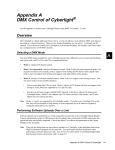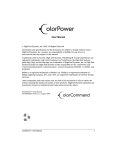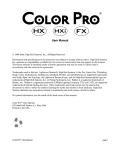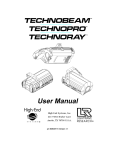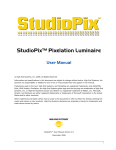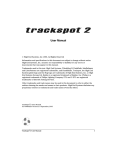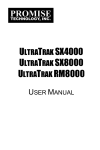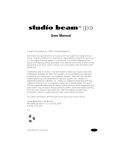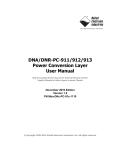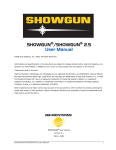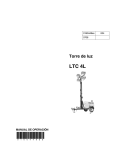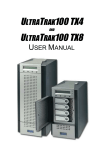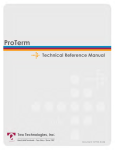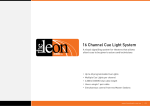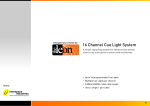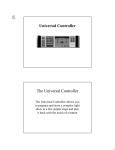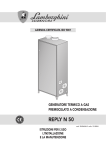Download EC-2™ - High End Systems
Transcript
EC-2 ™ User Manual © 2001, High End Systems, Inc., All Rights Reserved Information and specifications in this document are subject to change without notice. High End Systems, Inc. assumes no responsibility or liability for any errors or inaccuracies that may appear in this manual. The fixture software is furnished under a license agreement and may be used or copied only in accordance with the terms of the agreement. Trademarks used in this text: Lightwave Research, High End Systems, Color Pro, Studio Beam, EC-1, Wholehog, Studio Color, Technobeam, Intellabeam, Dataflash AF1000, and LithoPatterns are registered trademarks; and EC-2, ES-1, TalkBack, Studio Spot, the Hog logo, the Lightwave Research logo, and the High End Systems globe logo are trademarks of High End Systems, Inc. or Flying Pig Systems, Ltd. Belden is a registered trademark of Belden, Inc. Philips is a registered trademark of Philips Lighting Company. ETL and C-ETL are registered trademarks of Intertek Testing Services. Other trademarks and trade names may be used in this document to refer to either the entities claiming the marks and names or their products. High End Systems disclaims any proprietary interest in trademarks and trade names owned by others. For patent information, see the inside of the back cover of this manual EC-2 User Manual P/N 60600177 Version1.1 July, 2001 Printed in the USA S.G. EC-2 User Manual i Contacting High End Systems US and the Americas Sales Department: High End Systems, Inc. 2105 Gracy Farms Lane Austin, TX 78758 USA voice: fax: Customer Service: 512.836.2242 512.837.5290 High End Systems, Inc. 2105 Gracy Farms Lane Austin, TX 78758 USA voice: 800.890.8989 24-hour fax: 512.834.9195 24-hour voice mail: 512.837.3063 or 800.890.8989 U.S. New York High End Systems, Inc. New York 311 W. 43rd Street, Ste 400 New York, NY 10036 voice: fax: U.S. Los Angeles: 210.957.6840 212.957.4466 High End Systems, Inc. 8200 Haskell Avenue Van Nuys, CA 91406 USA voice: fax: 818.947.0550 818.908.8975 U.S. Orlando: voice fax: 407.296.3359 407.523.9092 Canada: voice: fax: 416.335.8537 416.335.8539 Europ High End Systems Europe LTD. 53 Northfield Road London W13 voice: fax: Singapore: High End Systems Singapore Pte. Ltd. 1 Tannery Road 06-05 Cencon 1 Singapore 1334 voice: FAX: World Wide Web: ii 44.20.8579.5665 44.20.8579.8469 +65 742 8266 +65 743 9322 http://www.highend.com EC-2 User Manual Warranty Information Limited Warranty Unless otherwise stated, your product is covered by a two year parts and labor limited warranty. Dichroic filters are not guaranteed against breakage or scratches to coating. It is the owner’s responsibility to furnish receipts or invoices for verification of purchase, date, and dealer or distributor. If purchase date cannot be provided, date of manufacture will be used to determine warranty period. Returning an Item Under Warranty for Repair It is necessary to obtain a Return Material Authorization (RMA) number from your dealer or point of purchase BEFORE any units are returned for repair. The manufacturer will make the final determination as to whether or not the unit is covered by warranty. Lamps are covered by the lamp manufacturer’s warranty. Any Product unit or parts returned to High End Systems must be packaged in a suitable manner to ensure the protection of such Product unit or parts, and such package shall be clearly and prominently marked to indicate that the package contains returned Product units or parts and with an RMA number. Accompany all returned Product units or parts with a written explanation of the alleged problem or malfunction. Ship returned Product units or parts to: 2105 Gracy Farms Lane, Austin, TX 78758 USA. Note: Freight Damage Claims are invalid for fixtures shipped in non-factory boxes and packing materials. Freight All shipping will be paid by the purchaser. Items under warranty shall have return shipping paid by the manufacturer only in the Continental United States. Under no circumstances will freight collect shipments be accepted. Prepaid shipping does not include rush expediting such as air freight. Air freight can be sent customer collect in the Continental United States. REPAIR OR REPLACEMENT AS PROVIDED FOR UNDER THIS WARRANTY IS THE EXCLUSIVE REMEDY OF THE CONSUMER. HIGH END SYSTEMS, INC. MAKES NO WARRANTIES, EXPRESS OR IMPLIED, WITH RESPECT TO ANY PRODUCT, AND HIGH END SPECIFICALLY DISCLAIMS ANY WARRANTY OF MERCHANTABILITY OR FITNESS FOR A PARTICULAR PURPOSE. HIGH END SHALL NOT BE LIABLE FOR ANY INDIRECT, INCIDENTAL OR CONSEQUENTIAL DAMAGE, INCLUDING LOST PROFITS, SUSTAINED OR INCURRED IN CONNECTION WITH ANY PRODUCT OR CAUSED BY PRODUCT DEFECTS OR THE PARTIAL OR TOTAL FAILURE OF ANY PRODUCT REGARDLESS OF THE FORM OF ACTION, WHETHER IN CONTRACT, TORT (INCLUDING NEGLIGENCE), STRICT LIABILITY OR OTHERWISE, AND WHETHER OR NOT SUCH DAMAGE WAS FORESEEN OR UNFORESEEN. EC-2 User Manual iii Warranty is void if the product is misused, damaged, modified in any way, or for unauthorized repairs or parts. This warranty gives you specific legal rights, and you may also have other rights which vary from state to state. iv EC-2 User Manual Table of Contents Contacting High End Systems ...................................................................................... ii Warranty Information .................................................................................................. iii Limited Warranty ........................................................................................... iii Returning an Item Under Warranty for Repair ............................................ iii Freight ............................................................................................................. iii Introduction Features ................................................................................................................. intro-1 Caution and Warning Symbols ............................................................................ intro-2 Cautions ......................................................................................................... intro-2 Warnings ........................................................................................................ intro-2 Specifications ........................................................................................................ intro-3 Electrical Specifications ................................................................................ intro-3 Physical Specifications .................................................................................. intro-3 Lamp Specifications ...................................................................................... intro-3 Environmental Specifications ....................................................................... intro-3 Cable and Connector Specifications ............................................................ intro-4 DMX 512 data cables: ............................................................................ intro-4 DMX 512 data connectors: .................................................................... intro-5 DMX 512 data terminator: ..................................................................... intro-5 Optional Accessories ............................................................................................ intro-5 Chapter 1 Setup and Installation Mounting Considerations ........................................................................................... 1-1 Wiring Considerations ............................................................................................... 1-1 Terminating the Fixture ...................................................................................... 1-2 Setting/Changing the Fixture Voltage ....................................................................... 1-2 Setting/Changing the Beam Angle ............................................................................ 1-3 Positioning the Zoom Lens ................................................................................. 1-3 Changing the Convex Lens ................................................................................. 1-5 Linking Fixtures ......................................................................................................... 1-5 Terminating the Link .......................................................................................... 1-6 Powering on the Fixture ............................................................................................ 1-6 Homing the Fixture .................................................................................................... 1-7 Assigning a DMX Start Channel ............................................................................... 1-7 Determining the Unique DMX 512 Start Channel ............................................ 1-8 Chapter 2 Operating the Fixture Programming Overview ............................................................................................. 2-1 Programming with a DMX Controller ...................................................................... 2-2 EC-2 Parameters ......................................................................................................... 2-5 EC-2 User Manual v Chapter 3 Troubleshooting and Maintenance Troubleshooting .......................................................................................................... 3-1 Upload and Crossload Troubleshooting ............................................................ 3-2 Interlock Sensor Switches .................................................................................. 3-3 Boot Code Copy Backup .............................................................................. 3-3 Status LEDs .......................................................................................................... 3-4 Other Status LED Indications ...................................................................... 3-5 Replacing Fuses ................................................................................................... 3-5 Replacing the Lamp ............................................................................................. 3-6 Optimizing the Lamp ........................................................................................... 3-8 Updating Software ...................................................................................................... 3-9 Appendix A DMX Control DMX Start Channels ................................................................................................. A-1 MSpeed Times ............................................................................................................ A-2 Appendix B Important Safety Information vi EC-2 User Manual List of Figures EC-2 Dimensions . . . . . . . . . . . . . . . . . . . . . . . . . . . . . . . . . . . . . . . . . . . . . . . . . . . . intro-4 Termination resistor placement . . . . . . . . . . . . . . . . . . . . . . . . . . . . . . . . . . . . . . . . . . . Rotate fixture and open access panel . . . . . . . . . . . . . . . . . . . . . . . . . . . . . . . . . . . . . . . Logic board . . . . . . . . . . . . . . . . . . . . . . . . . . . . . . . . . . . . . . . . . . . . . . . . . . . . . . . . . . . . Set jumpers to correct frequency and/or voltage . . . . . . . . . . . . . . . . . . . . . . . . . . . . . . Perimeter screw location . . . . . . . . . . . . . . . . . . . . . . . . . . . . . . . . . . . . . . . . . . . . . . . . . Locating the Beam Angle Slots . . . . . . . . . . . . . . . . . . . . . . . . . . . . . . . . . . . . . . . . . . . . Screw tightening order . . . . . . . . . . . . . . . . . . . . . . . . . . . . . . . . . . . . . . . . . . . . . . . . . . . Linking the fixtures. . . . . . . . . . . . . . . . . . . . . . . . . . . . . . . . . . . . . . . . . . . . . . . . . . . . . . 1-2 1-2 1-3 1-3 1-3 1-4 1-4 1-5 Locating Lamp Interlock switch . . . . . . . . . . . . . . . . . . . . . . . . . . . . . . . . . . . . . . . . . . . Status LEDs on EC-2 logic board . . . . . . . . . . . . . . . . . . . . . . . . . . . . . . . . . . . . . . . . . . Logic board access . . . . . . . . . . . . . . . . . . . . . . . . . . . . . . . . . . . . . . . . . . . . . . . . . . . . . . Fuse location . . . . . . . . . . . . . . . . . . . . . . . . . . . . . . . . . . . . . . . . . . . . . . . . . . . . . . . . . . . Opening the lamp assembly . . . . . . . . . . . . . . . . . . . . . . . . . . . . . . . . . . . . . . . . . . . . . . . Remove lamp from socket . . . . . . . . . . . . . . . . . . . . . . . . . . . . . . . . . . . . . . . . . . . . . . . . Lamp removal plate . . . . . . . . . . . . . . . . . . . . . . . . . . . . . . . . . . . . . . . . . . . . . . . . . . . . . 3-3 3-4 3-6 3-6 3-8 3-8 3-8 List of Tables Optional Accessories . . . . . . . . . . . . . . . . . . . . . . . . . . . . . . . . . . . . . . . . . . . . . . . . . intro-5 EC-2 Beam Angles . . . . . . . . . . . . . . . . . . . . . . . . . . . . . . . . . . . . . . . . . . . . . . . . . . . . . . 1-4 Example: Determining the DMX 512 Start Channel . . . . . . . . . . . . . . . . . . . . . . . . . . . 1-8 EC-2 DMX Protocol . . . . . . . . . . . . . . . . . . . . . . . . . . . . . . . . . . . . . . . . . . . . . . . . . . . . . 2-3 TalkBack parameters available on EC-2 fixtures . . . . . . . . . . . . . . . . . . . . . . . . . . . . . . 2-5 General Troubleshooting . . . . . . . . . . . . . . . . . . . . . . . . . . . . . . . . . . . . . . . . . . . . . . . . . Upload, Crossload, and TalkBack Troubleshooting . . . . . . . . . . . . . . . . . . . . . . . . . . . Status LEDs . . . . . . . . . . . . . . . . . . . . . . . . . . . . . . . . . . . . . . . . . . . . . . . . . . . . . . . . . . . . Description and Function of Fuses . . . . . . . . . . . . . . . . . . . . . . . . . . . . . . . . . . . . . . . . . 3-1 3-2 3-4 3-6 DMX Start Channels . . . . . . . . . . . . . . . . . . . . . . . . . . . . . . . . . . . . . . . . . . . . . . . . . . . . A-1 MSpeed Times . . . . . . . . . . . . . . . . . . . . . . . . . . . . . . . . . . . . . . . . . . . . . . . . . . . . . . . . . A-2 EC-2 User Manual vii viii EC-2 User Manual Introduction The Environmental Color-2 (EC-2™) fixture is a fully weatherized luminaire designed as a reliable high-performance solution for a variety of architectural settings. The EC-2 reflector is based on the patented reflector technology introduced in Technobeam® and uses the same long life MSD 250/2 lamp. Highefficiency optical design in combination with full CMY (cyan, magenta and yellow) subtractive color mixing system provides smooth infinite color mixing. Features • High-resolution DMX 512 Control. • TalkBack feature support to allow bi-directional communication between an EC-2 fixture on a DMX link and a controller with TalkBack capabilities. HandShake™ and Whole Hog™ controllers from High End Systems can utilize TalkBack with EC-2 and Color Pro Series fixtures. • High efficiency 2000 hour MSD 250/2 lamp developed by Philips® Lighting Co. in conjunction with High End Systems®, Inc. for long lamp life. • CMY subtractive color mixing • Precision stepper motors used to control dim flags, and color wheels. • Time code synchronization in stand-alone mode via Master/Slave links (synchronized preset playback) to any combination of Color Pro® series, EC-1®, ES-1™, Technobeam®, Studio Color® 575, Studio Spot®, Studio Color® 250, Studio Spot® 250 and Studio Beam™ fixtures. • Variable-speed strobe. • Full dimming and fade-to-black. • Yoke assembly to facilitate mounting. • Power factor correction. • LED status indicators on board. • Precision stepper motors. • Remote fixture power up and shut down. EC-2 User Manual intro-1 Caution and Warning Symbols The following international symbols appear in margins throughout this manual to highlight caution and warning messages: Cautions Not heeding these messages could result in personal injury and/or damage to equipment. Caution: This symbol indicates caution messages. Hot Surface: This symbol indicates a hot surface. Warnings Not heeding these messages could result in serious personal injury. Warning: This symbol indicates high voltage warning messages. Fire Hazard: This symbol indicates that a fire hazard is present. Eye Protection: This symbol indicates that eye protection is required. Explosion: This symbol indicates an explosion hazard. Minimum Distance: This symbol indicates the minimum distance to a lighted object, which in this case is 1 meter. Not Suitable for mounting directly on normally flammable surfaces. intro-2 EC-2 User Manual Specifications Electrical Specifications Warning: Factory setting: Class 1 equipment - This equipment must be earthed. 277V, 60Hz Selectable voltages: 100V, 50/60Hz, 3.75A 120V, 50/60Hz, 3.13A 208V, 50/60Hz, 1.8A 230V, 50/60Hz, 1.6A 277V, 50/60Hz, 1.35A Rated power: 375 W Fuses: F1 - 6.3A, 250V, Slow Blow only (5 mm x 20 mm) F2 - 3.5A, 250V, Slow Blow only (5 mm x 20 mm) Physical Specifications Fixture Type EC-2 Height 20.27 in. (514.9 mm) Width 10 in. (254 mm) Depth 16.72 in. (424.7 mm) Weight 46 lbs. (20.9 kg) For additional dimensions, refer to Figure intro-1. Lamp Specifications Lamp type: MSD 250/2, 250 watt, metal halide lamp, GY 9.5 base Color temperature: 6500 K Environmental Specifications Minimum distance to flammable objects: 1.0m (3.28ft) Minimum distance to lighted object: 1.0m (3.28ft) Maximum ambient temperature, (Ta): 40°C (104°F) Maximum exterior surface temperature: 212°C (176°F) Not Suitable for mounting directly on normally flammable surfaces. EC-2 User Manual intro-3 Figure intro-1. EC-2 Dimensions Cable and Connector Specifications DMX 512 data cables: Belden® 1419A or equivalent (meets specifications for EIA RS-485 applications) with the following characteristics: • 2 twisted pairs (4 conductors) plus a shield • maximum capacitance between paired conductors—30 pF/ft. Pin 1 Common • maximum capacitance between conductor and shield—55 pF/ft. Pin 3 DMX Data + Blue/White Stripe • maximum resistance of 20Ω/1000 ft. • nominal impedance 120Ω intro-4 Pin Function Color Code Shield Pin 2 DMX Data – White/Blue Stripe Pin 4 Aux Data – White/Orange Stripe Pin 5 Aux Data + Orange/White Stripe EC-2 User Manual DMX 512 data connectors: Standard: DMX data connectors hardwired into a pluggable terminal strip Optional: 5-pin male and female XLR connectors DMX 512 data terminator: 120Ω resistor Optional Accessories The following table lists the EC-2 optional accessories available from your High End Systems dealer/distributor. Table intro-1 Optional Accessories Part Description Part Number Replacement Philips® MSD250/2 lamp 55030051 Whole Hog® II Lighting Console 25020001 Handshake handheld controller 10020001 Neutrik 5-to-3 pin XLR convertor set 55050015 Neutrik 3-to-5 pin XLR convertor set 55050016 Heavy Duty 5-pin XLR cable (10’) 55050017 Heavy Duty 5-pin XLR cable (25’) 55050018 Heavy Duty 5-pin XLR cable (50’) 55050019 Heavy Duty 5-pin XLR cable (100’) 55050020 Galvanized safety cable 12040001 Narrow-angle pebble convex lens 99090052 Medium-angle pebble convex lens 99090051 Wide-angle pebble convex lens 99090050 Lens guard 99260367 Glare block 80071583 Lightwave Research® Upload Dongle 26040002 5-pin XLR Wallplate 49040001 EC-2 User Manual intro-5 intro-6 EC-2 User Manual Chapter 1 Setup and Installation 1 This chapter presents an overview of setup and installation considerations as well as instructions on setting the fixture voltage, setting the beam angle, and setting the DMX 512 start channel. For specific instructions on mounting and wiring instructions, see the EC-2 Installation Guide that was shipped with your fixture. Mounting Considerations Caution: 1) Not Suitable for mounting directly on normally flammable surfaces. 2) Maintain a minimum distance of 1 m (3.28 ft.) from combustible materials. 3) Maintain a minimum distance of 1 m (3.28 ft.) from lighted object. This means the fixture must be positioned at least 1 meter away from the object it is illuminating. The EC-2 fixture is designed for surface mounting on the ground or a wall. Ceiling and truss-mounting are not recommended using the EC-2 fixture’s installed yoke. If you adapt the fixture for a non-recommended application, verify the truss or other support will handle the weight of all the devices you are mounting. Each EC-2 fixture weighs 46 lbs. (20.9kg). Note: Certain orientations in ceiling mounting will make the fixture’s logic board susceptible to heat damage since the EC-2 has no fan and uses only natural convection for cooling. For instructions on mounting the EC-2, see the Installation Guide that came with your fixture. Wiring Considerations EC-2 requires installation by a qualified electrician according to the local electrical codes. The EC-2 is designed for permanent installation using conduit. Use Data grade cables specified in “Cable and Connector Specifications” on page Intro-4. For complete wiring instruction, see the EC-2 Installation Guide that came with your fixture. EC-2 User Manual Setup and Installation 1-1 Terminating the Fixture EC-2 fixtures are shipped with a package including one 120 ohm resistor for terminating the fixture. When mounting the fixture in a standalone application, the termination resistor must be attached to pins 2 and 3 of the data connector as shown in Figure 1-3). If you are adding the EC-2 to a link, see “Terminating the Link” on page 1-6. 5 4 3 2 1 Figure 1-1. Termination resistor placement Setting/Changing the Fixture Voltage EC-2 fixtures are factory-set to 277V, 60Hz. If your power source differs, you must change the fixture’s input voltage to match your power source. EC-2 has a selectable input voltage that allows you to choose 100V, 120V, 208V, 230V, or 277V at 50 or 60 Hertz frequency. The voltage range for each setting is ±10 percent. For example, if you have a 220V or 240V power source, use the 230V input setting. Warnings: 1) Disconnect power before servicing. 2) This fixture must be serviced by qualified personnel. The information in this section is intended to assist qualified service personnel only. 3) Be sure to match the voltage selection jumper to your power source prior to operating this equipment. You will need: • • • 1/4in. allen wrench small flathead screwdriver small phillips screwdriver To change the fixture’s voltage or frequency setting: 1. Disconnect power to the fixture. 2. Use the 1/4in. allen wrench to loosen the tilt screws on both sides of the yoke and rotate the fixture to the position shown in Figure 1-2. Tighten the tilt screws. Use a small, flathead screwdriver to loosen the access panel retaining screws and remove the access panel. Tilt screws Open access panel to logic board Figure 1-2. Rotate fixture and open access panel 3. Locate the voltage and frequency jumpers on the logic board (see Figure 1-3). 1-2 Setup and Installation EC-2 User Manual 4. To move a jumper, use the small phillips screwdriver to loosen the screw that secures the jumper end to the voltage or frequency contact. Remove the jumper end and re-insert it behind the screw for the desired voltage or frequency contact (see Figure 1-4). After you move the jumper, tighten its corresponding screw to secure the jumper to the pin. Frequency Jumper Voltage Jumper Frequency/Voltageselect jumper block 5 4 3 2 1 3 2 1 Figure 1-3. Logic board 5. After changing the voltage and/or frequency jumper, check that all the terminal screws are tightened securely. 6. Reattach the access panel. Tighten the panel screws to a torque setting between 3–4 ft.lb. (4–5 Nm) This action is needed to ensure a weather-tight seal. 100V 120V 208V 230V 277V 50Hz 60Hz Figure 1-4. Set jumpers to correct frequency and/or voltage Setting/Changing the Beam Angle The standard EC-2 fixture is shipped with a medium Perimeter pebble convex lens and an internal zoom lens. The Screws zoom lens can be positioned manually to obtain four different beam angles. Positioning the Zoom Lens To set or change the angle by adjusting the zoom lens, you will need: 3/16in. allen wrench To adjust the angle: 1. Loosen the eight perimeter screws with a 3/16in. Figure 1-5 Perimeter screw location allen wrench to open the housing, (see Figure 1-5). EC-2 User Manual Setup and Installation 1-3 1 Thumbscrew Beam Angle Slots A B C D Figure 1-6 Locating the Beam Angle Slots 2. Slide the front housing forward and tilt into position to access the lens, (see Figure 1-6). X 3. Loosen the thumbscrew on the lens assembly 4. Move the zoom lens into the correct slot for the beam angle you select. Table 1-1 shows the field angle metrics for each setting. Z \ 5. Retighten the thumbscrew. _ ] [ 6. Check that the housing gasket is secure. 7. Ensure that cables are not trapped; then raise the front housing and secure the top screw first. 8. Tighten the remaining perimeter screws in the order indicated in Figure 1-7 equalizing the torque to ensure a weathertight seal. ^ Y Figure 1-7 Screw tightening order Table 1-1 EC-2 Field Angles Pebble Convex Lens Type* Zoom Lens Position Narrow Medium Wide A 18° 22° 28° B 20° 24° 30° C 23° 27° 33° D 25° 29° 35° *Note: The EC-2 fixture is shipped with a medium pebble convex lens as standard. Narrow- or Wide-angle lens are also available. See “Optional Accessories” on page Intro-5. 1-4 Setup and Installation EC-2 User Manual Changing the Convex Lens You can also adjust the beam angle by replacing the pebble convex lens. To replace the convex lens you will need: • • 1 Optical assembly screws 3/16in. allen wrench 10/24in. allen wrench To replace the convex lens: 1. Loosen the front housing perimeter screws with a 3/16 allen wrench and open the fixture, (see Figure 1-5 and Figure 1-6). 2. Use the 10/24in. allen wrench to loosen the three socket screws which hold the optical assembly into the front housing as shown in Figure 1-8. Lift optical module up to expose the front lens retaining ring. Retaining ring Inner seal Convex lens Outer seal 3. Use the 10/24in. allen wrench to loosen the four socket screws around the retaining ring. Remove ring and inner rubber seal. 4. Remove lens, leaving the outer rubber seal in place. 5. Insert new lens. Replace inner rubber seal. Secure retaining ring with 3–4ft.lbs (4–5Nm) torque. Figure 1-8 Convex lens assembly 6. Replace and secure optical module. 7. Ensure that cables are not trapped; then raise the front housing and secure the top screw first. 8. Tighten the remaining perimeter screws in the order indicated in Figure 1-7 equalizing the torque to ensure a weathertight seal. Linking Fixtures The 8-channel protocol allows you to link up to 64* EC-2 fixtures on one DMX universe. *Note: You must use a DMX splitter to connect more than 32 fixtures per link. Connecting more than 32 devices per link without a DMX splitter will eventually deteriorate the digital signal. The 32 device limit complies with the EIA-485 standard. EC-2 User Manual Setup and Installation 1-5 Data Install termination resistor in the data connector of the last fixture on the link Power Power Source XLR Data Connection Figure 1-9. Linking the fixtures. To link fixtures to a controller and/or to each other with conduit requires data cabling. If you choose to construct your own cabling, it must adhere to the specifications listed in “Cable and Connector Specifications” on page Intro-4. Fixtures must be linked in a “daisy chain” as shown in Figure 1-9 to allow for accurate data transfer. Terminating the Link Each EC-2 fixture is shipped with a termination resistor. When linking fixtures together, only the last fixture on the link is terminated. EC-2 fixtures are terminated by inserting the resistor in pins 2 and 3 of the data connector as shown in Figure 1-1 on page 1-2. For complete instructions on linking EC-2 fixtures, see the installation guide that came with your fixture. Caution: High End Systems does not recommend running your fixtures off a dimmer. Powering on the Fixture Warning: This equipment for connection to a branch circuit having a maximum overload protection of 20A. EC-2 fixtures do not have a power switch and is intended for a connection to a power source with a disconnect that meets all national and local electrical code requirements. 1-6 Setup and Installation EC-2 User Manual Once connected, you can remotely power up or shutdown the fixture via the Control channel (see “Programming with a DMX Controller” on page 2-2). However, it is very important that you disconnect power from the fixture before performing adjustment, maintenance, and service procedures shown in this manual. 1 Homing the Fixture The fixture’s homing procedure verifies that the major functions of the fixture (color wheels and dim wheel) are oriented properly. The homing procedure is also used to bring the fixture out of shutdown mode. When you connect any EC-2 fixture to an appropriately-rated power source, the fixture automatically begins a homing procedure. You can also remotely home the fixture via the Control channel (see “Programming with a DMX Controller” on page 2-2). At the end of the homing procedure, the fixture lamp will strike and the shutter will open if there is no incoming DMX data. This allows for focusing and testing prior to programming. If the EC-2 is receiving DMX data, it will end the homing procedure in whatever state the DMX data defines for the fixture. Assigning a DMX Start Channel The DMX start channel identifies each unique fixture on a DMX link. If you plan to control your fixtures with a DMX controller (or using synchronized preset playback), you must assign a DMX start channel to each fixture on the link. However, if you always plan to use the fixture in stand-alone mode (without a controller or synchronized preset playback), you can skip this section. There are 512 available channels on each DMX link. These 512 channels are divided among all the devices on a particular link. The number of channels each fixture requires is called the fixture’s channel range. The DMX start channel is the first channel available to a fixture in its channel range. EC-2 fixtures have an 8-channel range. The fixture’s channel range must not overlap any other device’s channel range on the link.* When two devices on the same DMX 512 link have overlapping channel ranges, one or both devices will be disabled or behave erratically. *Note: The single exception to the non-overlapping rule is if you want the fixtures to respond to controller commands in exactly the same way. In this case, the fixtures must be the same type and be assigned the same protocol and the fixtures must share the entire channel range. If you plan to mix different fixture types (and/or protocols) on the same DMX link, see “Determining the Unique DMX 512 Start Channel” on page 1-8. If your DMX link will have only EC-2 fixtures, see Table A-1 on page A-1 for a listing of available DMX start channels for successive fixtures on the link. EC-2 User Manual Setup and Installation 1-7 Determining the Unique DMX 512 Start Channel To determine each fixture’s DMX start channel in a link, you must know the number of channels used by each fixture. Knowing that the first fixture on the link will use DMX start channel 1, you can determine the DMX start channel for each successive fixture by adding the number of DMX channels used by the fixture to the fixture’s DMX start channel. For example, in Table 1-9, 8 (channels used by EC-2 ) + 1 (DMX start channel for the first fixture) = 9 (DMX start channel for the next fixture on the link). Table 2-9. Example: Determining the DMX 512 Start Channel Fixture location on the link* Fixture name DMX 512 channels used per fixture DMX 512 start channel Channel range used First EC-2 8 channels C001 1-8 Second Other Device (using 14 channels) 14 channels C009 9-22 Third EC-2 8 channels C023 23-30 *Note: The fixture location on the link does not have to comply with this example. The fixtures can be addressed in any order on the link. If you have other fixtures in the link or plan to skip channels, note that the maximum address for the last EC-2 fixture on the link is 505. 1-8 Setup and Installation EC-2 User Manual Chapter 2 Operating the Fixture The EC-2 can be programmed for operation with a DMX-compatible controller or with preset programming (for stand-alone operation). Handshake™ and the Whole Hog® II controllers are the High End Systems controllers available with TalkBack capabilities. This chapter provides a programming overview, EC-2 DMX protocol and the TalkBack parameters available. Programming Overview A construct is a specific feature of the fixture that helps to define the “look” of the light beam (such as the color, effect, or dim level). A scene is a combination of all the available construct values you selected. When you play back more than one scene in sequence, it becomes a program. A program that continuously repeats is called a loop. Some constructs allow you to choose a construct value set by MSpeed (motor speed). Unlike other construct values which are completed in the shortest length of time after the motor starts moving, an MSpeed change occurs smoothly over the entire MSpeed time value you select. For example, if you select an MSpeed time of 30 seconds, the motor will gradually change position until it reaches its new destination at the end of 30 seconds. Using a DMX controller, you can program an unlimited number of sequences and retain direct control over the EC-2 fixtures at all times. You may choose to save time by programming your fixtures using a controller and then capturing the scene(s) to the onboard memory of multiple EC-2 fixtures.* *Note: Because controllers do not transmit crossfade or delay construct values, you must use preset programming to manually set those construct values for each fixture. You can use either a controller or the fixture’s on-board memory to create and play back scenes, but not both at the same time. In other words, you cannot create a scene using preset programming and play it back using a DMX controller. You also cannot use a controller while on-board scenes are playing. You can synchronize preset playback among all fixtures with no DMX controllers connected to the link. During synchronized preset playback, the master fixture (the fixture assigned DMX start channel 1) synchronizes playback for all fixtures. EC-2 User Manual Operating the Fixture 2-1 2 Programming with a DMX Controller When you program your fixtures with a DMX controller, you use the controller to assign a value to each of the fixture’s available constructs. Each construct is assigned to a specific DMX channel in the fixture’s channel range. Handshake™ and the Whole Hog® II Lighting Console are the DMX controllers available from High End Systems for EC-2 fixtures (see “Optional Accessories” on page Intro-5). Both of these controllers utilize TalkBack to allow remote access to parameters of High End Systems fixtures. Each High End Systems fixture has a number that uniquely identifies the fixture. High End Systems fixtures are also capable of bi-directional communications. Talkback requires a discovery process to find the unique number that is embedded inside each fixture, similar to a serial number. Whatever controller is being used that supports Talkback will go out and utilize a discovery process to find all the fixtures connected to the link. Once the fixtures have all been identified, using the Talkback protocol, all the current fixture parameter settings and information can be discovered. Fixture discovery can happen at anytime, but the Talkback messages are only valid after the fixture has completed homing, so it will not respond to any talkback message until homing is complete. TalkBack is implemented through the primary DMX link (pins 2-3) in a half-duplex communication mode. This means that it does not require pins 4-5 to be connected or used to receive talkback messages coming from the fixture. Note: If a conventional DMX data splitter is used between the fixture and the controller sending talkback commands, then the fixture data will not be able to return through the data splitter. The same holds true for any type of DMX processing device which regenerates the data link between its input and output (this includes HES Intellabeam fixtures and AF1000 strobes). For more information on whether your DMX controller will support EC-2 fixtures, and TalkBack™ contact the controller’s vendor. Table 2-1 lists the EC-2 constructs and their corresponding DMX controller values. If you have a numeric-type controller, use the Value Decimal (dec.) column. If you have a fader-type controller, use the Value Percentage (%) column. If your controller allows you to program hex values, use the Value (hex) column. The % values in the table may vary slightly depending on your controller’s rounding convention. 2-2 Operating the Fixture EC-2 User Manual Table 2-1 EC-2 DMX Protocol Channel Construct Description Value (dec.) Value (%) Value (hex) 0-255 0-100 00-FF 1 Dim Continuous Positioning (closed to open) Close 0-31 0-12 00-1F Periodic Strobe (Variable) 32-63 13-25 20-3F 2 Shutter (Note: Snap instantly opens or closes at full speed. Ramp opens or closes at specified speeds.) Random/Rand Strobe (Variable) 64-95 25-37 40-5F Random/Sync (Variable) 96-127 38-50 60-7F Ramp Open/Ramp Shut (Variable) 128-159 50-62 80-9F Random Ramp/Ramp (Variable) 160-191 63-75 A0-BF TBD (Reserved for future use) 192-223 75-88 C0-DF Open 224-255 88-100 E0-FF Full Speeds Continuous 3 Color Function 0-15 0-6 00-0F TBD 16-31 6-12 10-1F TBD 32-47 13-18 20-2F Spin (Puts all the color wheels in spin mode. Wheel spin speed, direction, or fixed position can be set individually on Red, Green, and Blue channels) 48-63 19-25 30-3F Cycle (3 wheels use color mix portion to cycle colors. Rate set by Red channel) 64-79 25-31 40-4F Color Scan (Puts all the color wheels in scan mode. Scans only the continuous color portion of the wheel - not the open “white” portion. Fixed position or scanning speed can be set individually on Red, Green, and Blue channels) 80-95 31-37 50-5F Random (3 wheels perform pseudo-random color chase. Rate set by Red channel) 96-111 38-44 60-6F 112-127 44-50 70-7F Blink (Closes shutter between color wheel changes. Blink Mode is defined using continuous wheel operation) MSpeed Controlled (same functional descriptions as Full Speeds) EC-2 User Manual Continuous 128-143 50-56 80-8F TBD 144-159 57-62 90-9F TBD 160-175 63-69 A0-AF Spin 176-191 69-75 B0-BF Cycle 192-207 75-81 C0-CF Color Scan 208-223 82-88 D0-DF Random 224-239 88-94 E0-EF Blink 240-255 94-100 F0-FF Operating the Fixture 2-3 2 Table 2-1 EC-2 DMX Protocol Channel Construct Description Value (dec.) Value (%) Value (hex) Continuous Mode Full Red Open 0 0 00 255 100 FF 0-127 0-50 00-7F Spin Mode Continuous Positioning 4 Red (-Cyan) Spin Reverse fastest (variable) 128-157 50-62 80-9D Spin Reverse slowest (variable) 158-187 62-73 9E-BB Spin Stop 188-195 74-77 BC-C3 Spin Forward slowest (variable) 196-225 77-88 C4-E1 Spin Forward fastest (variable) 226-255 89-100 E2-FF Color Scan Mode Continuous Positioning Scanning (slow to fast) 0-127 0-50 128-255 50-100 00-7F 80-FF Cycle & Random Modes Slow Rate 0 0 00 Fast Rate 255 100 FF Continuous Mode Full Green Open 0 0 00 255 100 FF 0-127 0-50 00-7F Spin Mode Continuous Positioning 5 Green (-Magenta) Spin Reverse fastest (variable) 128-157 50-62 80-9D Spin Reverse slowest (variable) 158-187 62-73 9E-BB Spin Stop 188-195 74-77 BC-C3 Spin Forward slowest (variable) 196-225 77-88 C4-E1 Spin Forward fastest (variable) 226-255 89-100 E2-FF Color Scan Mode Continuous Positioning Scanning (slow to fast) 0-127 0-50 128-255 50-100 00-7F 80-FF Continuous Mode Full Blue Open 6 2-4 Blue (-Yellow) 0 0 00 255 100 FF 0-127 Spin Mode Continuous Positioning 0-50 00-7F Spin Reverse fastest (variable) 128-157 50-62 80-9D Spin Reverse slowest (variable) 158-187 62-73 9E-BB Spin Stop 188-195 74-77 BC-C3 Operating the Fixture EC-2 User Manual Table 2-1 EC-2 DMX Protocol Channel 6 cont. Value (%) Value (hex) Spin Forward slowest (variable) 196-225 77-88 C4-E1 Spin Forward fastest (variable) 226-255 89-100 E2-FF Construct Blue (-Yellow) cont. Value (dec.) Description Color Scan Mode Continuous Positioning 0-127 Scanning (slow to fast) 0-50 128-255 50-100 7 MSpeed (see Table A-2 on page A-2) Safe (disables all Control settings) 8 Control (Note: The Shutter channel must be set to “0” to access Control channel settings.) 0-9 00-7F 80-FF 0-4 00-09 Home 60-68 24-27 3C-44 Lamp On 80-88 31-35 50-58 Lamp Off 90-98 35-38 5A-62 120-130 47 78 Shutdown* *Note: Fixture shutdown allows you to remotely deactivate the fixture. When a fixture is shut down, the lamp is extinguished, and power to the motors is disabled. If a fixture is in shutdown mode, you must home the fixture to bring it back into operation. EC-2 Parameters Table 2-2 describes the parameters available on the EC-2 fixture for configuration by a controller with DMX TalkBack capabilities. The HandShake™ controller from High End Systems provides access to all of these parameters. If you are using another DMX controller, check with the manufacturer to determine which parameters you can access. Table 2-2 TalkBack parameters available on EC-2 fixtures Parameter Options Description Settings Off Factory Defaults On Fixture Channel* C### Lamp Limit Enabled EC-2 User Manual Off On When you set this parameter on, all factory options return to their default settings. The factory defaults for EC-2 are: • Preset play mode—Off • Lamp Life Limit—Disabled • Data Loss—Short time-out Identifies the starting DMX address offset for the fixture. The EC-2 channel number can range from 1–505. Turn this parameter on to monitor the lamp life. When the lamp hours are 10% past the rated lamp life, the lamp will not strike. This is a safety feature to reduce potential lamp explosion. Operating the Fixture 2-5 2 Table 2-2 TalkBack parameters available on EC-2 fixtures Parameter Options A User Mode B Preset Play Mode Off On Long Data Loss Short Description Use this parameter to switch the user type between User A and User B. Each user type includes values for Fixture Channel, Lamp Limit Enabled, Preset Play Mode, and Data Loss parameters and 16 different preset scenes to give the fixture its total of 32 possible preset scenes. This parameter puts the EC-2 into Preset Playback mode to play the internally stored fixture presets and ignore incoming DMX. This parameter shuts off the shutter and lamp when no data is received for a period of time. The Short option closes the shutter after not receiving DMX data for 1 second and turns off the lamp after 5 minutes of no data activity. The Long option closes the shutter after a DMX data loss of 3-5 minutes and turns off the lamp after 5 minutes of no data activity. Operations Identify Fixture This parameter allows you to identify a fixture by causing that fixture to rapidly strobe when you address it. Boot Use this parameter to copy boot code after uploading new software to EC-2 fixtures. XLD Crossload allows you to copy the firmware from one fixture to another. This gives you the ability to bring all fixtures to the same software version. View Preset Scene Use this parameter to ignore incoming DMX data and play a selected scene. This allows you to view a scene isolated from its sequence. Copy User Mode A→B Setting B→A Use this parameter to copy the fixture’s user settings from User A to User B or from User B to User A. A→B Copy User Mode Presets B→A Use this parameter to copy the fixture’s user presets from User A to User B or from User B to User A. Each user type includes 16 different presets (scenes) that can be copied to the other user type. Copy User Mode A→B All B→A Use this parameter to copy the fixture’s 16 user presets and fixture setting from user A to user B or from user B to user A. Fixture Hour Reset Use this parameter to reset the hours the fixture has been on to 0 Self Tests Use this parameter to test channel operation on the following selections • Dim • Cyan • Magenta • Yellow • All Lamp Hour/ Strike Reset Use this parameter to reset the number of hours the current lamp has been on and the number of times the fixture has attempted to turn on (struck) to 0. 2-6 Operating the Fixture EC-2 User Manual Table 2-2 TalkBack parameters available on EC-2 fixtures Parameter Options Description Information On Lamp Status* Off Striking This parameter identifies the current state of the lamp as On, Off, in the process of Striking or Error if it is unable to strike. Error Lamp hours/ strikes* This parameter indicates the number of hours the current lamp has been on and the number of times the fixture has attempted to turn on (struck) the current lamp. Open Sensors Optical/Interlock Closed This parameter allows you to view the operation of this pair of sensors. Preset Play Status Off Scene # This parameter lets you view whether Presets are playing, and, if they are, it will display the current preset scene that is playing. R S 422 (D M X ) Operating Mode P reset P lay This parameter indicates the current data source S elf-Tests Temperature This parameter shows the current fixture temperature in degrees C Software Version* This parameter allows you to view the current software version *Note: The Whole Hog ®II lighting console provides access to these parameters plus error analysis. EC-2 User Manual Operating the Fixture 2-7 2 2-8 Operating the Fixture EC-2 User Manual Chapter 3 Troubleshooting and Maintenance This chapter lists typical symptoms and solutions for problems you might experience when using your EC-2 fixture. Information is also included on replacing parts, optimizing the lamp, and updating fixture software. Please note the warnings under each heading before servicing your fixture. Troubleshooting Table 3-1describes solutions to some general fixture problems. If the problem you are experiencing is not listed in this section or the solution listed does not solve the problem, contact High End Systems customer service (see “Contacting High End Systems” on page ii). Table 3-1 General Troubleshooting Problem Probable Cause No power is connected. Fixture will not Breaker is turned off. turn on. Power connectors are defective. Solution Connect power to the fixture. Turn the breaker on. Replace power connectors Replace the lamp (see “Replacing the Lamp” on page 3-6). Verify that the fixture’s DMX start channel and/or The DMX start channel for the channel range is valid for your controller and link (see fixture is incorrect. “Assigning a DMX Start Channel” on page 1-7). Fixture Provide correct power source voltage, and input functions but The voltage setting is voltage setting (see “Setting/Changing the Fixture lamp does not incorrect. Voltage” on page 1-2. strike. Allow the lamp to cool, then restrike the lamp either The lamp is currently too hot via the control channel (see “Programming with a to strike. DMX Controller” on page 2-2). The ignitor connection is Tighten the connection loose. The lamp is defective or the Replace lamp with the specified type (see “Replacing wrong type of lamp is installed the Lamp” on page 3-6). Lamp is Provide correct power source voltage or change The voltage setting is dimmer than input voltage setting (see “Setting/Changing the incorrect. other fixtures. Fixture Voltage” on page 1-2) Optimize the lamp (see “Optimizing the Lamp” on The lamp is not optimized. page 3-8). The lamp is defective. EC-2™ User Manual Troubleshooting and Maintenance 3-1 3 Table 3-1 General Troubleshooting Problem Probable Cause Solution The lamp socket is loose and causing arcing. Replace the lamp (see “Replacing the Lamp” on page 3-6). Allow the fixture 5 to 10 minutes to cool, then attempt to strike the lamp via the control channel (see “Programming with a DMX Controller” on page 2-2). Contact your Dealer or High End Systems Technical Support (1-800-890-8989). Color system does not produce the correct color. The fixture is not properly homed. Home the fixture (see “Homing the Fixture” on page 1-7). Fixture is not responding to controller commands or is producing unexpected results. The data cable is faulty. No controller is attached to the link or the controller is not generating any output. The fixture has an incorrect fixture number or DMX start channel. The link was not terminated. Test and replace the data cables as necessary. Verify that a controller is connected to the link and is generating output by sending commands to a known working device. Verify the DMX start channel does not overlap another fixture’s DMX start channel (see “Assigning a DMX Start Channel” on page 1-7). Terminate the link (see ). The lamp is defective. Lamp shuts off during operation. The fixture has exceeded the maximum temperature. Upload and Crossload Troubleshooting To find solutions to problems encountered while uploading or crossloading new software versions, see Table 3-2. Table 3-2 Upload, Crossload, and TalkBack Troubleshooting Problem Probable Cause Not all fixtures on the Defective DMX cable(s) link are receiving the upload. Cable(s) disconnected Cable(s) disconnected Fixture could not erase Flash ROM.” Defective cable(s) The fixture’s electrical circuitry is damaged Solution Test and replace cable(s) if necessary Reconnect DMX cable(s) Reconnect cable(s) Test and replace cable(s) as necessary Call High End Systems Technical Support (1-800-890-8989). If there is not a fixture at that address, ignore this message - if there is a fixture at that address, verify the DMX start channel (see “Determining the Unique DMX 512 Start Channel” on page 1-8). The controller was configured with a fixture at that address, but no fixtures There is no response were found there. from Fixture xx (Link xx Address xx).” Controllers, serial data distributors, data Remove or bypass the offending line Optoisolators, or fixture(s) using RSdevices from the data link or move 422 communication is connected before them after the EC-2 fixtures. EC-2 fixtures on the link. 3-2 Troubleshooting and Maintenance EC-2™ User Manual Table 3-2 Upload, Crossload, and TalkBack Troubleshooting Problem Probable Cause Solution The fixture’s Status LED periodically flashes rapidly on and off . Some manual intervention is needed to reset the fixture. Remove the lamp cap and the internal removal plate to activate the Interlock switch and automatically Copy the Boot code. See “Boot Code Copy Backup” below. Fixtures are not uploading or crossloading. Controllers, serial data distributors, data Remove or bypass any offending line Optoisolators, or fixture(s) using RSdevices from the data link or move 422 communication are connected them after the EC-2 fixtures. before EC-2 fixtures on the link. Interlock Sensor Switches The EC-2 has two interlock sensor switches as a safety feature. The first switch is located internally behind the lamp socket assembly. The other is on the front section of the fixture’s housing. If someone attempts to open either of these while the Lamp is on, an interlock switch shuts off the Lamp to protect from direct UV exposure. Boot Code Copy Backup The Lamp interlock has another function. If there is a new software upload for the EC-2, the Boot code needs to be changed. When this happens, the fixture gives a BOOT Error indicated by the status red LED flashing on and off rapidly and the Boot code must be manually copied. If your controller is utilizing Talkback, there is a command to Copy the Boot Code. If there is a problem that effects communications and Talkback is disabled, activating the Lamp interlock while the power is on will cause it to automatically Copy the Boot code. Note: User intervention is required for this function because of the extreme vulnerability of the fixture during this operation. Power failure during the Boot code copy operation could disable the fixture permanently. You will need: • 9/64in. allen wrench To Activate the Lamp interlock sensor switch: 1. Locate the lamp cap screws shown in Figure 3-1 and loosen with the 9/64in. allen wrench. 2. Remove the lamp cap. 3. Twist the internal lamp removal assembly to the left and pull straight out to disengage. This causes the Lamp interlock switch to shut off the lamp and automatically Copy the Boot code. EC-2™ User Manual Internal Lamp socket assembly Lamp Cap Screws Figure 3-1 Activating the Lamp Interlock switch to Copy the Boot code Troubleshooting and Maintenance 3-3 3 4. Reinsert the lamp assembly and twist to the right to lock (the arrow on the camlock plate points up in the locked position). Status LEDs Figure 3-2 shows the four Status LED’s on the EC-2 logic board as viewed through the access panel. Status See Table 3-3 for a LED description of the status LEDs. See Figure 3-3 on page 3-5 for location of Data access panel to logic LED board. Lamp LED Power LED Figure 3-2 Status LEDs on EC-2 logic board Table 3-3 Status LEDs LED Data Transmit (red LED) & Receive (green LED) Power Lamp (orange) Status (red— indication after Homing is complete) 3-4 Problem Indication? State solid red No OFF Not necessarily* flashing red No solid/flashing green OFF No Not necessarily* solid No OFF Yes solid No OFF flashing Normally off with one rapid flash on Normally off with two rapid flashes Normally on with one rapid flash off Normally on with two rapid flashes off Extended on or off Description Fixture is crossloading software to other fixtures on the link. No DMX 512 data is being transmitted. The fixture is in preset playback mode, and is the master fixture. Fixture is receiving data. No DMX 512 data is being received. The motor power supply is receiving adequate voltage. Fuse or power failure. The lamp power supply is receiving the proper voltage, and the lamp is ON. Not necessarily** Yes The fixture is unable to strike the lamp. No Normal DMX operation Yes Error in Normal DMX operation. No Preset playback operation, no errors Yes Error in Preset Playback operation Yes No connection to main program operation Troubleshooting and Maintenance The lamp is extinguished. EC-2™ User Manual *Note: The Transmit & Receive LED will not be on until you have connected the fixture to a DMX 512-compatible controller using data-grade cabling. If this LED remains OFF even though you have connected the fixture to a controller and are sending DMX 512 commands to the fixture, see “General Troubleshooting” on page 3-1. **Note: If you shut down the lamp using a remote shutdown command, the lamp and the Lamp LED will shut off. However, if you have defective data cables, no data cables/controller connected to the fixture, or the controller is off, the lamp and its LED will also be off. If correcting these problems does not turn the lamp on, see “General Troubleshooting” on page 3-1. Other Status LED Indications If the Status LED is rapidly flashing on and off periodically, it indicates a need for manual intervention to reset the fixture. Follow the procedure described in “Boot Code Copy Backup” on page 3-3 to automatically copy the Boot code. If the Status LED does not go to any kind of flashing state after a fixture has powered up for several minutes, to allow for homing, there is a problem with the logic board or with power to the fixture. Warnings: This fixture must be serviced by qualified personnel. The information listed in this section is intended to assist qualified personnel only. Disconnect power before servicing. Replace fuses with the specified type and rating only. Equipment surfaces may reach temperatures up to 80° C (176° F). Allow the fixture to cool before handling. Replacing Fuses You will need: • replacement fuse (see Table 3-4) • flathead screwdriver To replace either of the two fuses located on the fixture’s circuit board: 1. Access panel location Disconnect power to the fixture. If the fixture has been operating, allow the fixture to cool before handling. Figure 3-3. Logic board access EC-2™ User Manual Troubleshooting and Maintenance 3-5 3 2. Determine which fuse needs to be replaced by referring to Table 3-4. Table 3-4 Description and Function of Fuses Fuse Type and Rating Size F1 6.3 A, 250 V, Slow Blow only F2 2.5 A, 250 V, 5mm x 20mm Slow Blow only* 5mm x 20mm Protects Main fuse Logic board Symptom of Failure Fixture shuts down, all status LEDs are off, the fixture will not receive power, fuse filament is broken or fuse is black. Fixture shuts down, all status LEDs are off, the fixture will not receive power, fuse filament is broken or fuse is black. 3. Locate the access panel retaining screws (see Figure 3-3). 4. Using a flat head screwdriver, loosen the panel retaining screw and remove the access panel. 5. Locate the F1 and F2 fuses on the fixture’s circuit board (see Figure 3-4). 6. Replace the appropriate fuse(s) with a fuse of the same type and rating (see Table 3-4). 7. Check that the access panel gasket is secure in the gasket groove. 8. Re-attach the access panel. Tighten the panel screws to a torque setting between 3–4 ft.lb. (4–5Nm). This action is needed to ensure a weather-tight seal. F2 5 4 3 2 1 3 2 1 F1 Figure 3-4 Fuse location Replacing the Lamp Warnings:Disconnect power before re-lamping or servicing. Change the lamp if it becomes damaged or thermally deformed. An operating, unshielded MSD lamp emits ultraviolet and visible (UV-vis) radiation which could damage eyes and skin. Whenever you are working on or near an exposed lamp, wear protective eye gear. Never look directly at the lamp while the lamp is on. A hot lamp may be an explosion hazard. Do not open for five minutes after switching off. Wear eye and hand protection when re-lamping. Change shields, lenses, or ultraviolet screens if they become visibly damaged to such an extent that their effectiveness is impaired, for example, by cracks or deep scratches. Do not operate this equipment without complete lamp enclosure in place or if shields, lenses, or ultraviolet screens are damaged. Equipment surfaces may reach temperatures up to 80° C (176° F). Allow the fixture to cool before handling. 3-6 Troubleshooting and Maintenance EC-2™ User Manual You will need: • MSD 250/2, 250 watt, metal halide lamp, GY 9.5 base* • protective gloves and eyewear • 9/64in. allen wrench *Note: Use only the MSD 250/2 lamp in your fixture, not the MSD 250. EC-2 fixtures are optimized for the MSD 250/2 lamp and will give reduced performance with other lamps. To install/replace the lamp: 1. Disconnect power to the fixture. If the fixture has been operating, wait for the lamp to cool before handling. 2. Put on your protective eyewear and gloves. 3. Locate and loosen the lamp cap screws (see Figure 3-5a) with the 9/64in. allen wrench. Remove the lamp cap. 4. Twist the lamp socket assembly to the left and pull straight out of the fixture (see Figure 3-5b). Note: The lamp assembly is connected to the fixture by lamp socket wires (see Figure 3-5a). Hold the assembly while replacing the lamp. Do not allow the lamp socket wires to support the weight of the lamp assembly. 5. 3 Lamp Cap Screws Figure 3-5a Removing the lamp socket assembly Twist left and pull to open Figure 3-5b Lamp removal plate Holding the existing lamp by its ceramic base, carefully pull the lamp straight out of the lamp socket on the lamp assembly (see Figure 3-5c). Caution: 6. Lamp socket wires Figure 3-5c Remove lamp from socket Do not squeeze the lamp glass while removing the existing lamp from the socket. Lamp glass may shatter. Remove all packaging materials from the new lamp. Holding the new lamp by its ceramic base, gently press the two base pins into the lamp socket until the lamp is firmly seated. Caution: When handling the new lamp, avoid contact with the lamp glass. If the lamp glass is soiled by oil or dirt from skin, gloves, etc., clean the cold EC-2™ User Manual Troubleshooting and Maintenance 3-7 lamp glass with an alcohol wipe. A soiled lamp could overheat and burst, causing damage to the fixture. 7. Reinsert the lamp assembly straight into the fixture (and reflector). Caution: Make sure the lamp socket wires are not wrapped around the lamp or crimped in the assembly while reinserting the lamp. If the lamp socket wires are wrapped around the lamp or crimped, the lamp and fixture could be damaged. 8. Holding the lamp removal plate, insert and twist the assembly to the right to lock in place (the arrow on the plate will point up in the locked position). 9. Before replacing the outer lamp cap, optimize the new lamp (see “Optimizing the Lamp” below). 10. Replace the lamp cap and tighten the lamp cap screws. 11. Reset the lamp hours to zero so that you can track the lamp life. If desired, enable the lamp warning message to send an error message to the DMX controller via TalkBack when the current lamp hours exceed 2,000. Optimizing the Lamp You should optimize the lamp in a EC-2 fixture after you replace the lamp, or if you notice a “hot spot” of brightness anywhere other than the center of the light beam. 1. Power up the fixture. 2. When automatic homing is complete, set fixture to the open white position. Note: If the EC-2 fixture is disconnected from DMX data, this happens automatically. Lamp optimization screws 3. Orient the fixture so that the beam will project onto a flat, white surface at least 10 feet (3 m) away. 4. Turn the lamp on. 5. Locate the X, Y, and Z optimization 9/64” hex screws (see Figure 3-6). 6. Look at the wall where the beam is projected and use the three optimization screws to adjust the lamp’s position within the fixture until the beam is at its maximum brightness and the light level is even across the beam (or the “hot spot” of brightness is at the center of the beam). 7. Go to step 10 in “Replacing the Lamp” above. 3-8 Troubleshooting and Maintenance Figure 3-6 Lamp optimization EC-2™ User Manual Updating Software Updating EC-2 fixture software is fast and easy. The latest versions of software are provided on the High End Systems web site, and are also available through High End Systems customer service (see “Contacting High End Systems” on page ii). There are three ways to upload new software to your EC-2 fixtures: 1. Attach a High End Systems Upload Dongle to your computer and upload the software to a EC-2 fixture. To use a High End Systems Upload Dongle, you will need a 386-based (or faster) computer, MS DOS® version 3.3 (or later) or Windows 95/98, and one MB of free disk space. To obtain an Upload Dongle (with installation and operation instructions), contact your High End Systems dealer/distributor (see “Contacting High End Systems” on page ii). 2. Upload the new software using the Handshake controller or another controller supporting TalkBack. 3. Crossload software from one fixture that contains the new software to all other EC-2 fixtures. Before you can upload or crossload new software, you must disconnect any controllers, bypass any serial data distributors and/or data line optoisolators, and bypass or make sure that any fixtures using RS-422 communications (such as Dataflash® AF1000 xenon strobes, and Intellabeam® fixtures) are located after the EC-2 fixtures on the link. These devices will block communication with any other EC-2 fixtures on the link. If the upload or crossload fails see “Upload and Crossload Troubleshooting” on page 3-2. EC-2™ User Manual Troubleshooting and Maintenance 3-9 3 3-10 Troubleshooting and Maintenance EC-2™ User Manual Appendix A DMX Control This appendix includes tables which list appropriate DMX start channels and MSpeed time conversions. For a listing of the EC-2 fixture’s color matching to Rosco® and Lee® common gel colors, refer to the High End Systems’ web page (see “Contacting High End Systems” on page ii). DMX Start Channels Table A-1 lists the DMX start channels for EC-2 fixtures. This table assumes that the fixtures are all assigned to the same link, one after another, and that all fixtures use 8 channels.. Table A-1. DMX Start Channels Fixture Order in the Link DMX Start Channel Fixture Order in the Link DMX Start Channel Fixture Order in the Link DMX Start Channel 1 1 23 177 45 353 2 9 24 185 46 361 3 17 25 193 47 369 4 25 26 201 48 377 5 33 27 209 49 385 6 41 28 217 50 393 7 49 29 225 51 401 8 57 30 233 52 409 9 65 31 241 53 417 10 73 32 249 54 425 11 81 33 257 55 433 12 89 34 265 56 441 13 97 35 273 57 449 14 105 36 281 58 457 15 113 37 289 59 465 16 121 38 297 60 473 17 129 39 305 61 481 18 137 40 313 62 489 19 145 41 321 63 497 20 153 42 329 64 505 21 161 43 337 22 169 44 345 EC-2™ User Manual A-1 A *Note: You can connect up to 64 fixtures to one DMX link. Although there are enough available DMX channels to link up to 64 fixtures you must use a DMX splitter to connect more than 32 fixtures per link. The 32 device limit complies with the EIA-485 standard. Connecting more than 32 devices per link without a DMX splitter will eventually deteriorate the digital signal. MSpeed Times Table A-2 lists the MSpeed (motor) movement times and their corresponding DMX controller values. If you have a numeric-type controller, use the Value Decimal (dec.) column. If you have a fader-type controller, use the Value Percentage (%) column. If your controller allows you to program hex values, use the Value (hex) column. The values in Table A-2 may vary slightly depending on your controller’s rounding convention. Table A-2. MSpeed Times Time (sec.) Value Value Value Time (dec.) (%) (hex) (sec.) Value (dec.) Value Value (%) (hex) Time (sec.) Value (dec.) Value Value (%) (hex) 0.15 255 100 FF 1.92 234 92 EA 7.22 213 84 D5 0.15 254 100 FE 2.09 233 91 E9 7.56 212 83 D4 0.17 253 99 FD 2.27 232 91 E8 7.91 211 83 D3 0.19 252 99 FC 2.46 231 91 E7 8.27 210 82 D2 0.21 251 98 FB 2.66 230 90 E6 8.63 209 82 D1 0.25 250 98 FA 2.86 229 90 E5 9.00 208 82 D0 0.29 249 98 F9 3.07 228 89 E4 9.39 207 81 CF 0.35 248 97 F8 3.29 227 89 E3 9.77 206 81 CE 0.41 247 97 F7 3.52 226 89 E2 10.17 205 80 CD 0.47 246 96 F6 3.76 225 88 E1 10.58 204 80 CC 0.55 245 96 F5 4.00 224 88 E0 10.99 203 80 CB 0.63 244 96 F4 4.25 223 87 DF 11.41 202 79 CA 0.73 243 95 F3 4.52 222 87 DE 11.84 201 79 C9 0.83 242 95 F2 4.78 221 87 DD 12.28 200 78 C8 0.94 241 95 F1 5.06 220 86 DC 12.72 199 78 C7 1.05 240 94 F0 5.34 219 86 DB 13.17 198 78 C6 1.18 239 94 EF 5.64 218 85 DA 13.63 197 77 C5 1.31 238 93 EE 5.94 217 85 D9 14.10 196 77 C4 1.45 237 93 ED 6.25 216 85 D8 14.58 195 76 C3 1.60 236 93 EC 6.56 215 84 D7 15.07 194 76 C2 1.75 235 92 EB 6.89 214 84 D6 15.56 193 76 C1 A-2 EC-2™ User Manual Table A-2. MSpeed Times Time (sec.) Value Value Value Time (dec.) (%) (hex) (sec.) 16.06 192 75 16.57 191 17.09 190 17.61 18.14 Value (dec.) Value Value (%) (hex) Time (sec.) Value (dec.) Value Value (%) (hex) C0 40.23 155 61 9B 75.38 118 46 76 75 BF 41.04 154 60 9A 76.49 117 46 75 75 BE 41.85 153 60 99 77.60 116 45 74 189 74 BD 42.68 152 60 98 78.71 115 45 73 188 74 BC 43.50 151 59 97 79.84 114 45 72 18.68 187 73 BB 44.34 150 59 96 80.98 113 44 71 19.23 186 73 BA 45.19 149 58 95 82.12 112 44 70 19.79 185 73 B9 46.04 148 58 94 83.27 111 44 6F 20.36 184 72 B8 46.90 147 58 93 84.43 110 43 6E 20.93 183 72 B7 47.77 146 57 92 85.59 109 43 6D 21.51 182 71 B6 48.65 145 57 91 86.77 108 42 6C 22.10 181 71 B5 49.54 144 56 90 87.95 107 42 6B 22.70 180 71 B4 50.43 143 56 8F 89.14 106 42 6A 23.30 179 70 B3 51.33 142 56 8E 90.34 105 41 69 23.92 178 70 B2 52.24 141 55 8D 91.55 104 41 68 24.54 177 69 B1 53.16 140 55 8C 92.76 103 40 67 25.17 176 69 B0 54.09 139 55 8B 93.98 102 40 66 25.80 175 69 AF 55.02 138 54 8A 95.21 101 40 65 26.45 174 68 AE 55.96 137 54 89 96.45 100 39 64 27.10 173 68 AD 56.91 136 53 88 97.70 99 39 63 27.76 172 67 AC 57.87 135 53 87 98.95 98 38 62 28.43 171 67 AB 58.84 134 53 86 100.22 97 38 61 29.11 170 67 AA 59.81 133 52 85 101.49 96 38 60 29.80 169 66 A9 60.79 132 52 84 102.77 95 37 5F 30.49 168 66 A8 61.78 131 51 83 104.05 94 37 5E 31.19 167 65 A7 62.78 130 51 82 105.35 93 36 5D 31.90 166 65 A6 63.79 129 51 81 106.65 92 36 5C 32.62 165 65 A5 64.80 128 50 80 107.96 91 36 5B 33.34 164 64 A4 65.82 127 50 7F 109.28 90 35 5A 34.08 163 64 A3 66.85 126 49 7E 110.61 89 35 59 34.82 162 64 A2 67.89 125 49 7D 111.94 88 35 58 35.57 161 63 A1 68.94 124 49 7C 113.28 87 34 57 36.33 160 63 A0 69.99 123 48 7B 114.63 86 34 56 37.09 159 62 9F 71.05 122 48 7A 115.99 85 33 55 37.87 158 62 9E 72.13 121 47 79 117.36 84 33 54 38.65 157 62 9D 73.20 120 47 78 118.73 83 33 53 39.44 156 61 9C 74.29 119 47 77 120.12 82 32 52 EC-2™ User Manual A A-3 Table A-2. MSpeed Times Time (sec.) 121.51 Value Value Value Time (dec.) (%) (hex) (sec.) 81 32 51 160.49 Value (dec.) 55 Value Value (%) (hex) 22 Time (sec.) Value (dec.) Value Value (%) (hex) 37 204.88 29 11 1D 122.91 80 31 50 162.09 54 21 36 206.70 28 11 1C 124.31 79 31 4F 163.71 53 21 35 208.52 27 11 1B 125.73 78 31 4E 165.33 52 20 34 210.36 26 10 1A 127.15 77 30 4D 166.96 51 20 33 212.19 25 10 19 128.58 76 30 4C 168.60 50 20 32 214.04 24 9 18 130.02 75 29 4 170.25 49 19 31 215.90 23 9 17 131.47 74 29 4A 171.91 48 19 30 217.76 22 9 16 132.92 73 29 49 173.57 47 18 2F 219.63 21 8 15 134.39 72 28 48 175.24 46 18 2E 221.51 20 8 14 135.86 71 28 47 176.92 45 18 2D 223.40 19 7 13 137.34 70 27 46 178.61 44 17 2C 225.30 18 7 12 138.82 69 27 45 180.30 43 17 2B 227.20 17 7 11 140.32 68 27 44 182.01 42 16 2A 229.11 16 6 10 141.82 67 26 43 183.72 41 16 29 231.03 15 6 0F 143.33 66 26 42 185.44 40 16 28 232.96 14 5 0E 144.85 65 25 41 187.17 39 15 27 234.90 13 5 0D 146.38 64 25 40 188.90 38 15 26 236.84 12 5 0C 147.92 63 25 3F 190.65 37 15 25 238.79 11 4 0B 149.46 62 24 3E 192.40 36 14 24 240.75 10 4 0A 151.01 61 24 3D 194.16 35 14 23 242.72 9 4 09 152.57 60 24 3C 195.92 34 13 22 244.70 8 3 08 154.14 59 23 3B 197.70 33 13 21 246.68 7 3 07 155.71 58 23 3A 199.48 32 13 20 248.68 6 2 06 157.30 57 22 39 201.28 31 12 1F 250.68 5 2 05 158.89 56 22 38 203.08 30 12 1E 252.68 4 2 04 A-4 EC-2™ User Manual Appendix B Important Safety Information Warning: For Continued Protection Against Fire 1. This equipment is designed for use with a 250 Watt, GY 9.5 base, metal halide lamp only. Use of any other type lamp may be hazardous and may void the warranty. 2. Maintain minimum distance of 1.0 meter (3.28 feet) from combustible materials. 3. Replace fuses only with the specified type and rating. 4. Observe minimum distance to lighted objects of 1.0 meter (3.28 feet). 5. This equipment for connection to branch circuit having a maximum overload protection of 20 A Warning: For Continued Protection Against Electric Shock 1. Class I equipment. This equipment must be earthed. 2. Disconnect power before re-lamping or servicing. 3. Refer servicing to qualified personnel; no user serviceable parts inside. B Warning: For Continued Protection Against Exposure To Excessive Ultraviolet (UV) Radiation 1. Do not operate this equipment without complete lamp enclosure in place or if shields, lenses, or ultraviolet screens are damaged. 2. Change shields, lenses, or ultraviolet screens if they have become visibly damaged to such an extent that their effectiveness is impaired, for example by cracks or deep scratches. 3. Never look directly at the lamp while lamp is on. Warning: For Continued Protection Against Injury To Persons 1. Use secondary safety cable when mounting this fixture. 2. Caution: hot lamp may be an explosion hazard. Do not open for 5 minutes after switching off. Wear eye and hand protection when re-lamping. 3. Equipment surfaces may reach temperatures up to 80° C (176° F). Allow 5 minutes for cooling before handling. 4. Change the lamp if it becomes damaged or thermally deformed. EC-2 User Manual B-1 Appendice B Importantes Informations Sur La Sécurité Mise En Garde: Pour Une Protection Permanente Contre Les Incendies 1. Cet appareil est conçu uniquement pour une lampe métallique à halogène, de 250 watts, à base GY 9.5. Son utilisation avec tout autre type de lampe peut être dangereuse et annuler la garantie. 2. Maintenir à une distance minimum de 1.0 mètre de matières inflammables. 3. Ne remplacer les fusibles qu'avec des modèles et valeurs assignées recommandés. 4. Respecter une distance minimum de 1.0 mètre par rapport aux objets éclairés. 5. Cet appareil de connection au circuit comporte une protection contre les surcharges de 20 A. Mise En Garde: Pour Une Protection Permanente Contre Les Chocs Électriques 1. Débrancher le courant avant de changer les lampes ou d'effectuer des réparations. 2. À l'intérieur de l'équipement il n'y a pas de pièces remplaçables par l' utilisateur. Confiez l'entretien à un personnel qualifié. 3. Equipement de Classe I. Cet équipement doit être mis à la terre. Mise En Garde: Pour Une Protection Permanente Contre Des Expositions Excessives Aux Rayons Ultra Violets (UV) 1. Ne pas utiliser cet appareil si le boîtier de la lampe n'est pas complètement fixé ou si les blindages, lentilles, ou écrans ultraviolets sont endommagés. 2. Changer les blindages ou les écrans ultraviolets s'ils sont visiblement endommagés au point que leur efficacité aient été altérée, par exemple par des fissures ou de profondes égratignures. 3. Ne jamais regarder directement la lampe quand celle ci est allumée. Mise En Garde: Pour Une Protection Permanente Contre Les Blessures Corporelles 1. Lors de l'assemblage, utiliser un câble de sécurité secondaire. 2. AVERTISSEMENT: les lampes chaudes comportent un risque d'explosion. Après l'avoir éteinte, attendre 5 minutes avant de la dégager. Lors du remplacement de la lampe, une protection des yeux et des mains est requise. 3. Les surfaces de l'appareil peuvent atteindre des températures de 80 C. Laisser refroidir pendant 5 minutes avant la manipulation. 4. Changer la lampe si elle est endommagée ou thermiquement déformée. B-2 EC-2 User Manual Anhang B Wichtige Hinweise Für Ihre Sicherheit Warnung: Zum Schutz Vor Brandgefahr 1. Dieses Gerät ist nur für den Gebrauch mit einer 250-Watt, Metall-Halogen-Lampe mit GY 9.5-Sockel konzipiert. Der Gebrauch irgend eines anderen Lampentyps könnte Sie gefährden und Ihre Garantie außer Kraft setzen. 2. Stets einen Mindestabstand von 1 Meter zu brennbaren Materialien einhalten. 3. Zum Ersatz nur Sicherungen verwenden, die dem vorgeschriebenen Typ und Nennwert entsprechen. 4. Einen Mindestabstand von 1 Meter zu den angestrahlten Objekten einhalten. 5. Dieses Gerät darf nur an eine Zweigleitung mit einem Überlastungsschutz von höchstens 20 A angeschlossen werden. Warnung: Zum Schutz Gegen Gefährliche Körperströme 1. Vor dem Austauschen von Lampen oder vor Wartungsarbeiten stets den Netzstecker ziehen. 2. Servicearbeiten sollten nur von Fachpersonal ausgeführt werden. Das Gerät enthält keine wartungsbedürftigen Teile. 3. Dieses Gerät gehört zur Klasse I. Dieses Gerät muß geerdet werden. Warnung: Zum Schutz Gegen Übermässige Ultraviolett (UV)Bestrahlung 1. Benutzen Sie dieses Gerät nur, wenn das komplette Lampengehäuse fest eingebaut ist; ebenfalls dürfen keine der Schutzabdeckungen, Linsen oder der UV-Schutz Beschädigungen aufweisen. 2. Die Schutzabdeckungen, Linsen und der UV-Schutz müssen ausgewechselt werden, wenn sie sichtlich dermaßen beschädigt sind, daß sie ihre Wirksamkeit einbüßen, z.B. infolge von Rissen oder tiefen Kratzern. 3. Nie direkt in die eingeschaltete Lampe schauen. Warnung: Zum Schutz Vor Verletzungen 1. Verwenden Sie bei der Installation des Beleuchtungskörpers ein zusätzliches Sicherheitskabel. 2. VORSICHT: Bei einer heiße Lampe besteht Explosionsgefahr. Nach dem Abschalten der Netzspannung sollten Sie etwa 5 Minuten warten, bevor Sie das Lampengehäuse öffnen. Schützen Sie beim Auswechseln der Lampen Ihre Hände und tragen Sie eine Schutzbrille. 3. Die Oberflächen des Gerätes können Temperaturen bis zu 80 C erreichen. Vor dem Anfassen stets 5 Minuten lang abkühlen lassen. 4. Falls die Lampe beschädigt oder durch Wärmeeinwirkung verformt ist, muß sie ausgewechselt werden. EC-2 User Manual B-3 B Apéndice B Información Importante De Seguridad Advertencia: Para Protección Continua Contra Incendios 1. Este equipo está diseñado para utilizarse únicamente con la lámpara de haluro metálico, de 250 vatios y base GY 9.5. El uso de cualquier otro tipo de lámpara puedá resultar peligroso, y puedá anular la garantía. 2. Mantenga una distancia mínima de materiales combustibles de 1.0 metro. 3. Cambie los fusibles únicamente por otros que sean del tipo y la clasificación especificadas. 4. Guarda una distancia mínima a objetos iluminados de 1.0 metro. 5. Este equipo debe conectarse a un circuito que tenga una protección máxima contra las sobrecargas de 20 A. Advertencia: Para La Protección Continua Contra Electrocuciones 1. Desconecte el suministro de energía antes de recambiar lámparas o prestar servicio de reparación. 2. Derive el servicio de reparación de este equipo al personal calificado. El interior no contiene repuestos que puedan ser reparados por el usuario. 3. Equipo de Clase I. Este equipo debe conectarse a la tierra. Advertencia: Para Protección Continua Contra La Exposición A Radiación Ultravioleta (UV) Excesiva 1. No opere este equipo sin tener colocada en su lugar la caja protectora completa de la lámpara o bien, si el blindaje, los lentes o las pantallas ultravioletas están dañadas. 2. Cambie el blindaje, los lentes o las pantallas ultravioleta si nota una avería visible, a tal grado que su eficacia se vea comprometida. Por ejemplo, en el caso de grietas o rayaduras profundas. 3. Jamás mire directamente a la lámpara en tanto ésta esté encendida. 4. Advertencia: Para Protección Continua Contra Lesiones Corporales 5. Al montare questa apparechiatura, usare un secondo cavo di sicurezza. 6. Precaución: una lámpara caliente puede constituir un peligro de explosión. No la abra por 5 minutos luego de haberla apagado. Lleve puestos, un protector ocular, y guantes al recambiar lámparas. 7. Las superficies del equipo pueden alcanzar temperaturas máximas de 80 grados centígrados. Deje que se enfríen por 5 minutos antes de tocarlas. 8. Cambie la lámpara si ésta se avería o deforma por acción térmica. B-4 EC-2 User Manual Appendice B Importanti Informazioni Di Sicurezza Avvertenza: Per Prevenire Incendi 1. Questa apparecchiatura è stata progettata per l'uso esclusivo con lampada a sali metallici da 250 watt, base GY 9.5. L'uso di qualsiasi altro tipo di lampada può essere pericoloso e può annullare la garanzia. 2. Mantenere l' apparecchio a un minimo di 1.0 metri (3.28 piedi) di distanza dai materiali combustibili. 3. Rimpiazare i fusibili usando soltanto quelli del tipo e della taratura adatta. 4. Mantenere una distanza minima di 1.0 metri (3.28 piedi) dagli oggetti accesi. 5. Questa apparecchiatura e' da collegarsi ad un circuito con una protezzione da sovraccarico massima di 20 amperes. Avvertenza: Per Prevenire Le Scosse Elettriche 1. Disinnestare la corrente prima di cambiare la lampadina o prima di eseguire qualsiasi riparazione. 2. Per qualsiasi riparazione rivolgersi al personale specializzato. L' utente non deve riparare nessuna parte dentro l' unita'. 3. Aparecchio di Classe I. Questa apparecchiatura deve essere messa a terra. B Avvertenza: Per Proteggersi Contro Le Radiazioni Dei Raggi Ultravioletti 1. Non usare questa apparecchiatura se il sistema di chiusura della lampadina non e' completo o se gli scudetti, le lenti, o gli schermi ultravioletti si sono visibilmente danneggiati di maniera tale che la loro efficacia sia stata ridotta --- ad esempio, se vi sono visibili spaccature o graffi profondi. 2. Mai guardare direttamente verso la lampadina quando sia accesa. Avvertenza: Per Non Ferire Ad Altre Persone 1. Use cable secundario de seguridad al montar este aparato. 2. Avvertenza: la lampadina calda potrebbe esplodere. Spegnerla per 5 minuti prima di aprirla. Usare protezzioni per le mani e per gli occhi prima di cambiare la lampadina. 3. Le superfici della apparecchiatura possono arrivare a temperature di 80 gradi centrigradi (176 gradi f). Aspettare 5 minuti prima di maneggiare. 4. Cambiare la lampadina se si danneggia o se si e' deformata dovuto alle alte temperature. EC-2 User Manual B-5 Vigtig Sikkerhedsinformation Advarsel: Beskyttelse mod elektrisk chock. Vigtigt! Lederne med gul/groen isolation maa kun tilsluttes en klemme maerket eller B-6 EC-2 User Manual



















































